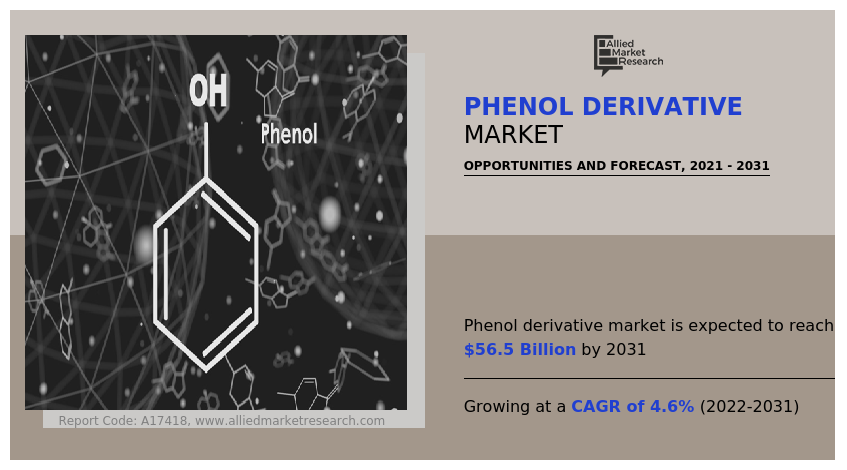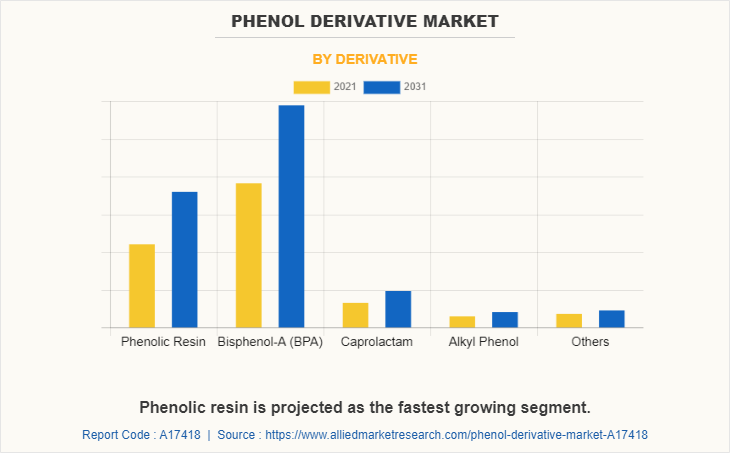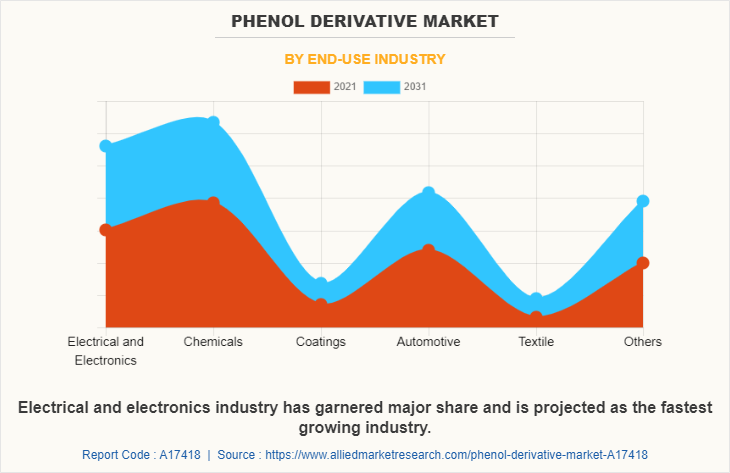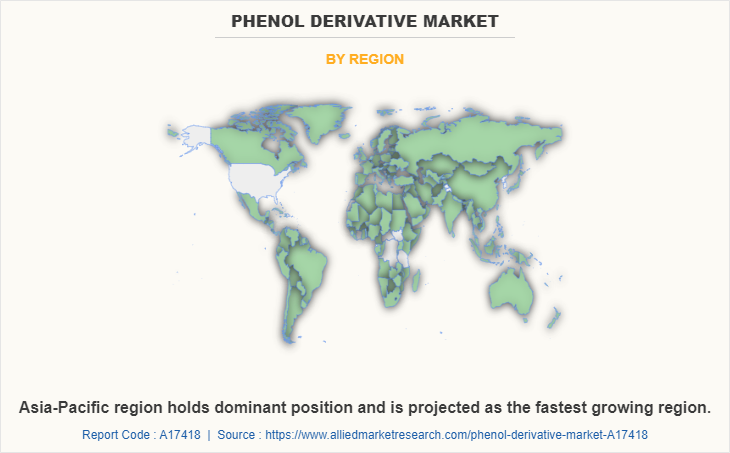Phenol Derivative Market Research, 2031
The global phenol derivative market was valued at $36.6 billion in 2021 and is projected to reach $56.5 billion by 2031, growing at a CAGR of 4.6% from 2022 to 2031.
Phenol is an aromatic white crystalline molecule with phenyl and hydroxy groups that are covalently linked. It is primarily used as a precursor in the synthesis of essential industrial compounds such as caprolactam, bisphenol-A, alkyl phenol, phenolic resins, and others. These compounds have extensive uses in numerous industries, including automotive, electronics, coatings, chemical intermediates, and among others. In addition, phenol's chemical structure consists of closely bound hydroxyl and phenyl groups that share the same functional properties as alcohol. Thus, it is also utilized to derive compounds that can be used in commercial cleaning solutions. The substantial demand for phenol derivatives from a variety of end-use industries is anticipated to fuel market expansion throughout the forecast period.

The rising demand for phenol and phenol derivatives in the chemical and pharmaceutical industries is expected to drive the phenol derivatives market's expansion during the forecast period. In addition, the expanding usage of phenol as a feedstock for a wide range of chemicals and derivatives will positively influence the market expansion. In addition, phenol is economical and appealing to the consumer industry, which will stimulate market expansion. In addition, the increase in the use of phenols as an industrial cleaner for electronic devices and equipment parts is expected to propel market expansion over the forecast period.
Furthermore, increasing the use of common items such as liquid detergents, mouthwash, floor cleaners, disinfectants, and inks contribute to the expansion of the market. In addition, the increasing use of phenols in the Indian pharmaceutical industry for the production of various drugs is offering market expansion potential. Global economic growth has been a significant factor in the expansion of the residential and commercial construction industries. As phenolic resins are utilized in the production of laminated beams, plywood, and flooring panels, this presents a profitable opportunity for the phenol derivatives market.
The phenol has various advantages, including deeper win insights and attribution around drivers, as well as improved sales targeting efficiency, but it also has a few limitations. Phenol is a caustic substance that can cause serious burns if exposed to the lungs, skin, or eyes. This aspect is anticipated to inhibit market expansion. In addition, stringent government and environmental regulations in North American and European nations are anticipated to restrain market expansion. In addition, a prohibition on BPA in the U.S. and Europe is expected to impede the market's growth over the projection period.
The phenol derivatives market is segmented on the basis of derivative, end-use industry, and region. Depending on the derivative, the market is categorized into phenolic resin, bisphenol-A (BPA), caprolactam, alkyl phenol, and others. On the basis of end-use industry, the market is categorized into electrical and electronics, chemicals, coatings, automotive, textile, and others. On the basis of region, the market is studied across North America, Europe, Asia-Pacific, and LAMEA.
The phenol derivative market is segmented into Derivative and End-Use Industry.

The bisphenol-A (BPA)segment accounted for the largest share i.e., 52.2%, due to increased demand for the production of printed circuit boards, LEDs, keyboards, and computers. The phenolic resin segment is expected to be the fastest growing segment, at around 5.1% CAGR during the forecasted period, this is due to increased demand for circuit board production from the electronics industry.

The chemicals segment accounted for the largest share i.e., 26.5%, due to its antimicrobial, analgesic, anti-inflammatory, and antioxidant properties. The Electrical and electronics and others segment is the fastest growing segment, at around 5.3% CAGR over the forecasted period. This is due to increased demand for new technologies as a result of increased modernization.

Asia-Pacific contributed 49.1% market share in 2021 and is projected to grow at a CAGR of 5.3% during the forecast period. Asia-Pacific occupied a major share in the Phenol derivatives market owing to the increased demand for phenol derivatives from the construction and electronics industries.
Major players operating in the global phenol derivatives market include Cepsa, Covestro AG, Dow Inc., Exxon Mobil Corporation, Formosa Chemicals & Fibre Corp, Hexion Inc, Honeywell International Inc., Ineos, Kumho P & B Chemicals., Inc, Mitsubishi Chemical Holdings Corporation, Mitsui Chemicals, Inc, PTT Phenol Company Limited, SABIC, Shell Plc, and Solvay SA. Other players operating in the phenol derivatives market are Chang Chun Group., Versalis S.p.A., Taiwan Prosperity Chemical Corporation, and Altivia.
Key Benefits For Stakeholders
- This report provides a quantitative analysis of the market segments, current trends, estimations, and dynamics of the phenol derivative market analysis from 2021 to 2031 to identify the prevailing phenol derivative market opportunities.
- The market research is offered along with information related to key drivers, restraints, and opportunities.
- Porter's five forces analysis highlights the potency of buyers and suppliers to enable stakeholders make profit-oriented business decisions and strengthen their supplier-buyer network.
- In-depth analysis of the phenol derivative market segmentation assists to determine the prevailing market opportunities.
- Major countries in each region are mapped according to their revenue contribution to the global market.
- Market player positioning facilitates benchmarking and provides a clear understanding of the present position of the market players.
- The report includes the analysis of the regional as well as global phenol derivative market trends, key players, market segments, application areas, and market growth strategies.
Phenol Derivative Market Report Highlights
| Aspects | Details |
| Market Size By 2031 | USD 56.5 billion |
| Growth Rate | CAGR of 4.6% |
| Forecast period | 2021 - 2031 |
| Report Pages | 342 |
| By Derivative |
|
| By End-Use Industry |
|
| By Region |
|
| Key Market Players | Exxon Mobil Corporation |
Analyst Review
According to the perceptive of the CXOs of leading companies, the growth of the phenol derivatives market is boosted by advances in the biological analysis of phenolic compounds for determining their medicinal potential. Olive oil-derived phenol is among the new sources being investigated. An increasing number of phenol derivatives are employed in the production of a variety of home goods, hence boosting their demand. The high profitability of the market for phenol derivatives has been sustained by the sector's wide range of applications. Paints & coatings, maritime, electrical, and construction increasingly employ phenol derivatives. As an example, increasing demand for phenolic resins in the synthesis of synthetic polymers has contributed to their increased popularity. They are also employed as decorative laminates. An increase in demand for materials used as fire retardants and heat-resistant is bolstering the outlook for the market for phenol derivatives.
The phenol derivatives market attained $36.6 billion in 2021 and is projected to reach $56.5 billion by 2031, growing at a CAGR of 4.6% from 2022 to 2031.
Chemical is the leading industry in the Phenol Derivative Market.
Asia-Pacific is the largest regional market for Phenol Derivative.
Increasing demand from the electrical and electronics industry is the upcoming trend of the Phenol Derivative Market in the world
The rising demand for phenol and phenol derivatives in the chemical and pharmaceutical industries is expected to drive the phenol derivatives market's expansion during the forecast period. In addition, the expanding usage of phenol as a feedstock for a wide range of chemicals and derivatives will positively influence the market growth.
Cepsa, Covestro AG, Dow Inc., Exxon Mobil Corporation, Hexion Inc, Honeywell International Inc., Ineos, Mitsubishi Chemical Holdings Corporation, Mitsui Chemicals are the top companies to hold the market share in Phenol Derivative.
COVID-19 has negative impact on phenol derivatives market owing to decreased in demand from various end use industries.
Loading Table Of Content...


